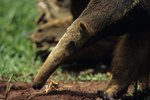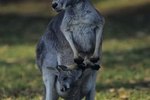
The mysterious city of Timbuktu conjures up images of desert travelers passing through dusty streets past ancient mud-brick mosques and 15th century relics. But these travelers and residents at the edge of the Sahara aren't just nomads, Malians and tourists: Timbuktu boasts wildlife perfectly acclimated to the harsh surroundings.
Camel
Camel caravans frequently pass just outside of Timbuktu, loaded with wares or ready to be sold or traded at the Berabish nomads' camel market. Arabian camels have a longtime relationship with the unforgiving Sahara: the dromedary is nature's best sand-traversing machine with wide feet, nostrils that can shut, long eyelashes to keep out any sandstorms and a body highly adaptable to extreme temperature shifts. Camels take advantage of watering faucets in Timbuktu before settling down to graze and rest for the evening outside of town.
Aardvark
The range of the "earth pig," as aardvark means in Afrikaans, stops just short of the Sahara and spreads through much of Africa. This nocturnal animal burrows to escape the hot sun during the day and comes out after dark to dig up some termites or ants to munch. Like the camel, the aardvark can close its nostrils to keep out sand, but opens up its nose to employ its strong sense of smell to find dinner. They can be found after dark around Timbuktu.
Bat
Bats make up a fourth of all mammal species on the planet, according to Defenders of Wildlife, and Timbuktu has its share of these flying rodents. Thankfully for this town, the bats that congregate in abandoned buildings -- and occasionally fly into an occupied house -- come out at dawn and dusk to eat insects, something of which Timbuktu has no shortage. Beetles, flies, preying mantis, spiders, locusts and others all call the desert home.
Hippo
The Niger River flows a few miles to the south past Timbuktu before bending and heading toward the Gulf of Guinea. This offers a perfect environment for the world's third largest land mammal. Hippos in the Niger are more visible when the water is lower; otherwise, it can be just a peek of the ears and nose above the water line or a massive footprint left on the shore. It's just as well that they enjoy their river lair as the hippo can be aggressive. They will emerge to graze on grass, but rely on the cooling effects of mud and water in this hot African environment.
Jackal
Those screams piercing the otherwise quiet desert night in Timbuktu are easily recognizable -- a wily relative of the dog, the jackal. Feeding sometimes on prey but largely on plants and insects, the jackal has a versatile hunting ability that can take down everything from gazelles to grasshoppers. Some Timbuktu locals believe the skin of the jackal brings good luck and will use it to make a guerba, a pouch in which water is held.
References
Photo Credits
-
John Foxx/Stockbyte/Getty Images




